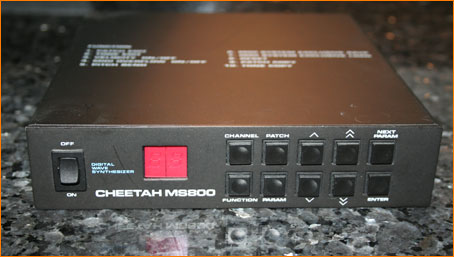August 4, 2010
by GForce Software
If you’re British, middle aged and a bit of a synth anorak, the chances are you will have heard of Cheetah. If not, the chances are you won’t know anything about them.
With a background in computer peripherals, Cheetah entered the music instrument business in 1987 with their relatively affordable MK5 controller keyboard and followed this by expanding their product range into drum machines, synths and sequencers, all aimed towards the cash-strapped musician.
One of the most unfathomable instruments ever made.
In the early 1990’s after a good degree of success, Cheetah released one of the quirkiest digital synths ever produced, their MS800. This affordable Digital Wave Sequencing Synthesiser had an interesting spec sheet and sound, in addition to the honour of being one of the most unfathomable instruments ever made – it was mind numbingly confusing to program, not just in terms of setting up a sound but even something as simple as changing a MIDI channel on the MS800 could cause an aneurism.
GForce’s Chris Macleod knows this from first hand experience because during the 1980s, after designing sounds for various musicians and companies, Cheetah asked him if he’d be interested in creating sounds for their forthcoming ‘fully programmable’ digital instrument.
Never one to turn down the chance to work with a new piece of gear he jumped at the opportunity.
Look before you leap
The instrument arrived, was unpacked, plugged in and there it sat not making a sound for the next 5 hours.
The preproduction unit didn’t have a single factory sound, well, not that I could bloody well find.
Chris Macleod
“During the course of the next few weeks I translated the manual into a series of diagrams and charts that visually allowed me to understand the ‘flow’ of the parameters, after which I set about creating ‘Tones’ and ‘Patches’ for this 15 note polyphonic, multi-timbral, filterless (what?), stereo bell box. The most bizarre thing is that you couldn’t hear your parameter changes in real-time. You have to enter ‘edit mode’ adjust your parameters and then exit ‘edit mode’ to hear your changes.”
Beyond daft? We think so because given its almost totally incomprehensible editing system could it have been a contributing factor to Cheetah vanishing soon after the MS800’s release?
Nonetheless the MS800 had an almost unique tone and parameter structure which made it sonically interesting and reasonably useful back in the day. Nowadays though, we think it’s a more interesting box of tricks than it was back then and the tones that you can coax from it provides a great counterbalance to analogue. The best description of the MS800’s sound we’ve heard is “a PPG meets a Wavestation via a Sid Station.”
And finally
The Cheetah MS800 remains the most difficult instrument to program on the planet – If you don’t believe us trawl the net and find a manual. Once you’ve read it, if you’re still interested in giving it a go, let us know, we’ve still got ours.
